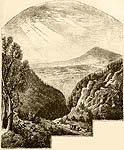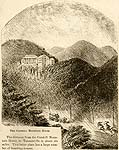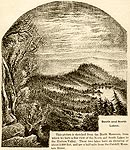|
|
Greene County
By H. Schile |
|

Descending into Kaaterskill Clove

Rip Van Winkle's House

The Catskill Mountain House
|
Cauterskill Clove
A pretty road leads from the plain to the Clove. At certain points we notice rocks, which are formed in layers, and are thickly covered with a beautiful foliage. The mingling of the gray color of the rock with the rich green of the foliage and moss, produces a very pretty effect. Further on, a charming rustic bridge takes us over the Kaaterskill Creek. To the left a peculiarly shaped rock is seen. It is perfectly bare and smooth, rising like a tower placed there by human hands. On the other side, it it almost concealed with rich and verdant foliage. This mass of rocks extends, for quite a distance, until interrupted by mighty ravines, which sometimes reach a depth of 1500 feet. As can be imagined, the whole scene is exceedingly romantic.
Rip Van Winkle's House
We are now in the neighborhood of Rip Van Winkle's Glen; so named by Washington Irving. It is not at all to be wondered at, that this great genius drew his poetical inspiration from this spot, for abounds in such wild, romantic beauty as would naturally excite such susceptible minds as that of the author of "Rip Van Winkle," and cause his genius to soar on the wings of poetical imagination! We know it to be unnecessary to repeat here the charming story of Rip's sleep.. A great American comedian, one of the finest of the age, Joseph Jefferson, has made this delightful legend familiar to the whole English speaking world.
A clear, sparkling little rivulet rune in merry glee through the valley, and on .it s way passes a broad, flat. rock. On the-top of this rock stands an old weather-beaten hut, called
"Rip Van Winkle's House." Opposite to it stands, an old fashioned farm-house. The road leads from here upwards to North Mountain, and suddenly turning a corner, we behold the Mountain House upon a mighty rock before us, which affords a most imposing view.
The Catskill Mountain House.
The well known Catskill Mountain House is now fifty-eight years old, for it was established in the year 1824. It is about twelve miles west of-the village of Catskill, and nearly 2,700 feet above the level of the sea. This venerable summer resort is built upon a large,
projeoting platform. For fifty-eight years it has withstood the storms and inclemency of
the weather, almost as proof against the assaults of time as the mountain itself, upon
which it stands. The hotel is charmingly situated. It stands in the very heart of that neighborhood which is the scene of the greater partof the Dutch and Indian legends. We mention only two names: that of Rip Van Winkle, and of our great artist, Thomas Cole, who had lived there. Were we to repeat the names of all the celebrities in art and literature, and of the distinguished foreigners, who have stopped at this hotel, we should be obliged to enlarge this book much beyond the scope we intend it should embrace. To relate all the anecdotes of this place would fill volumes.
The surrounding country is very charming; it abounds in pathways, leading in every direction. Especially are the well: known water-falls in, this vicinity a source of pleasure and attraction.
The distance from the Catskill Mountain House is abot six miles. The latter place has a large number of boarding-houses.
The distance from Tannersville to Hunter is about four miles.
|
Sunset Rock.
Looking from here upwards, the country all around seems to have a tablet form.
We are in a fair distance from the mountain-chain of the Hunter Mountain and its neighbors, and,
through this distance the mountains seem to be clad in a bluish gauze, or haze.
Below, in the valley, we behold the waters of Haines' Fall winding along; but the
summer often dries it into emptiness. The outwashed and outwhetted stones and the big trunks of
trees seen around—of the latter of which it is but
plainly visible that the storm or the rush of the water of the Falls has torn them from the ground—bear witness of the occasional power of this waterfall, and of the great strength of the storms raging at times in these parts. Casting a glance over the plain, all around appears in bright green colors. The foliage of the neighborhood is richest in firs and butternut-trees. Upward to the height, a lovely moss covers the ground. As seen from the picture, there is an enormous gray rock in the front, in the clefts of which traces of a weather-beaten, needle-like foliage are to be found. Large portions of the rocky mass are covered with moss, and the changes of the colors produce charming effects. |
|

South and North Lakes
|
South Lake
In the table-formed highland, lying between the South and the North Mountains, two lakes can be found. The larger one is the South Lake, lying hidden amidst luxuriant forests. The water of the sea is exuberantly overgrown with bog and marsh plants, and on 'hut summer days one can often see the water-serpent sunning itself on the broad
leaves of the plants. The most fabulous stories are told of this place, which is but natural, inasmuch as the country around was full of unpleasant insects and the sea full of serpents. Man and beast kept aloof from the place, and at times even the brave Indian, who is accustomed to face and to brave all danger, looked with suspicion upon and approached with fear this place. But since this neighborhood has been so much frequented by summer boarders, and a great part of the old forest destroyed, all its former wilderness has disappeared. A small streamlet flowing from this lake forms the Kaaterskill Fall, and directly westward along the mountains it runs until it reaches the nearest end of a precipitated, rocky mass. Beneath this rock it forms a small pond where the waters gather again, and there it falls with mighty velocity to a depth of 185 ft. Thence from cave to cave it runs until at last amid roars and foaming it falls into the vale below and winds its way through the clove towards and into the Hudson. But it is finally the fall looked upon and viewed from a standpoint; at the second grade the most magnificent sight, imaginable in all nature presents itself. Not only Hunter Mountain with her neighbors in view, but the Fall itself presents the peculiar appearance of having its falling water swayed by the air, thus causing the dewy drops to be carried far, very far away all around into the neighboring country, just as the winds may blow. The rays of the sun in passing through these dewy drops floating in the air produces a display and a blending of colors more effective and superior in beauty than a rainbow's heavenly splendor. |
Hunter.
Hunter is situated, in a wide valley. One of the remarkable views connected with it, is that of Stony Clove, three miles distant. The roads here, which run in every direction, are excellent.
Hunter Mountain is the highest in Greene County, being somewhat over 4000 ft, high. Colonel Chair Mountain is over 1500 feet high above the village.
Hunter is furnished with all the latest facilities and improvements of a modern village, viz: a telegraph office, stage line, stores, churches and schools. Thus it is far from being a wilderness. The distance from Hunter to Lexington is nine miles, and from the latter place to Westkill it is three miles.
|

Panorama As Viewed From Black Dome.
|
Panorama As Viewed From Black Dome.
Black Dome is a little over 4000 feet in height. From here one can see the whole succession of all the high mountains, whose crests project above the mist and fog. This picture corresponds to the description found ill the Indian legends. They called this chain of mountains "The mountains in the sky." The crests of these mountains being illuminated by the bright rays of the sun, whilst mist and fog enshroud them below, gives them a very ghostly appearance.
Owing to the movement of the fog produced by the sun's rays endeavoring to penetrate it, the, crests of the mountains appear to sway in mid-air.
It was in this part of the country that Thomas Cole lived; it was from here that this truly great artist drew the inspiration of his masterpiece "The Voyages of Life," which he represented in four beautiful paintings.
|
|

Westkill - Deo Brothers' Hotel

Farming In Greene County
|
Deep Notch From Westkill To Shandaken
This is a romantic and picturesque ravine, which cuts through these high mountains and leads from Greene to Ulster County. It is very appropriately called "Deep Notch." A beautiful valley extends from Lexington to Westkill. The pathway represented in our picture, leads directly to the hotel of Messrs. Deo Brothers. This is a very popular house for summer boarders; situated, as it is, at the foot of the mountain, it resembles a European scene. But a few steps from the hotel, and we are in the very midst of the Deep Notch. The nearer we approach Ulster County, the more romantic becomes the deep, narrow pass. This ravine bears a striking similarity to that at Stony Clove, which is even wilder in its beauty than Deep Notch.
The distance from the hotel of Messrs. Deo Brothers at Westkill to the Lamment's Hotel at Shandaken, is about seven miles. A mail-coach runs daily between these two places and also from Westkill to Lexington, from here to Hunter. From Hunter you can go through the beautiful Stony Clove, joining at Phoenicia, Ulster County. Then again, you can go from Hunter to Tannersville through the beautiful Cauterskill Clove to Catskill Village, Greene County. All these places can be reached back and forth by mail-coach daily, which connect with the Ulster and Delaware Rail Road.
|
|
|







